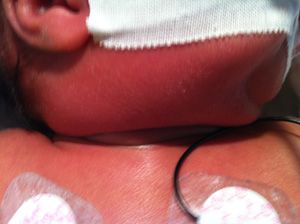Cellulitis-Adenitis From Late-Onset Group B Streptococcus Infection
A 2-month-old infant had right submandibular swelling with inflammation and induration up to the nape of neck. Ultrasonography showed multiple enlarged lymph nodes with soft tissue swelling. Blood cultures grew Gram-positive cocci, which were identified as group B streptococci. Late-onset GBS infection is acquired from colonized household contacts.
A 2-month-old infant, born at 26 weeks’ gestation, was discharged from the neonatal ICU after a prolonged stay. Two weeks later, his parents brought him to the emergency department (ED) after 1 day of fever and fussiness. There were no preceding upper respiratory tract infection symptoms, vomiting, diarrhea, or rash. There was no history of sick contacts.

By the time the patient was seen in the ED, he was in shock with respiratory failure. He received fluid boluses and was intubated. Initial nasal washes were positive for influenza virus B. He was admitted to the pediatric ICU, where he continued to have worsening lactic acidosis. Polymerase chain reaction assay results were positive for respiratory syncytial virus but negative for influenza virus. Therapy with broad-spectrum antibiotics was started.
Lumbar puncture results were negative for meningitis.
The patient had right submandibular swelling with signs of inflammation and induration extending up to the nape of neck (Figure). Ultrasonography of the neck showed multiple enlarged lymph nodes with soft tissue swelling. Blood cultures grew gram-positive cocci, which were identified as group B streptococci (GBS).
This infant had 2 previous sepsis workups, both of which were negative. His mother was also GBS-negative.
He was treated with cefotaxime for a total of 10 days.
Group B Streptococcal Infection
Early-onset GBSinfection presents within 24 hours of birth, most commonly within the first week of life. The infection is acquired in utero or during passage through a contaminated birth canal.
Late-onset GBS infection presents between 1 week and 3 months of age. Infection is acquired from colonized household contacts. In our patient's case, screening is in progress. However, this infant had a twin in whom GBS sepsis also developed; the twin was admitted the following day.
Late, late-onsetGBS infection presents beyond 3 months of age. This infection is more common in infants born before 7 months’ gestation.
Maternal intrapartum antibiotic prophylaxis prevents early-onset GBS infection but has no effect on late-onset infection.
Cellulitis-adenitis may present as facial or submandibular cellulitis or it may involve any other part of the body. Cellulitis-adenitis accounts for 4% of all late-onset GBS infections.1 Of those affected, 90% have associated bacteremia.2 CNS involvement is very common. Mortality in preterm infants varies from 5% to 7%.3
References:
References
1. Yagupsky P, Menegus MA, Powell KR. The changing spectrum of group B streptococcal disease in infants: an eleven year experience in a tertiary care hospital. Pediatr Infect Dis J. 1991;10:801-808. http://www.ncbi.nlm.nih.gov/pubmed/1749691
2. Albanyan EA, Baker CJ. Is lumbar puncture necessary to exclude meningitis in neonates and young infants: lessons from the group B streptococcus cellulitis–adenitis syndrome. Pediatrics. 1998;102(4, pt 1):985-986. http://pediatrics.aappublications.org/content/102/4/984.extract
3. Phares CR, Lynfield R, Farley MM, et al. Epidemiology of invasive group B streptococcal disease in the United States, 1999-2005. JAMA. 2008;299:2056-2065. http://www.ncbi.nlm.nih.gov/pubmed/18460666
Recognize & Refer: Hemangiomas in pediatrics
July 17th 2019Contemporary Pediatrics sits down exclusively with Sheila Fallon Friedlander, MD, a professor dermatology and pediatrics, to discuss the one key condition for which she believes community pediatricians should be especially aware-hemangiomas.